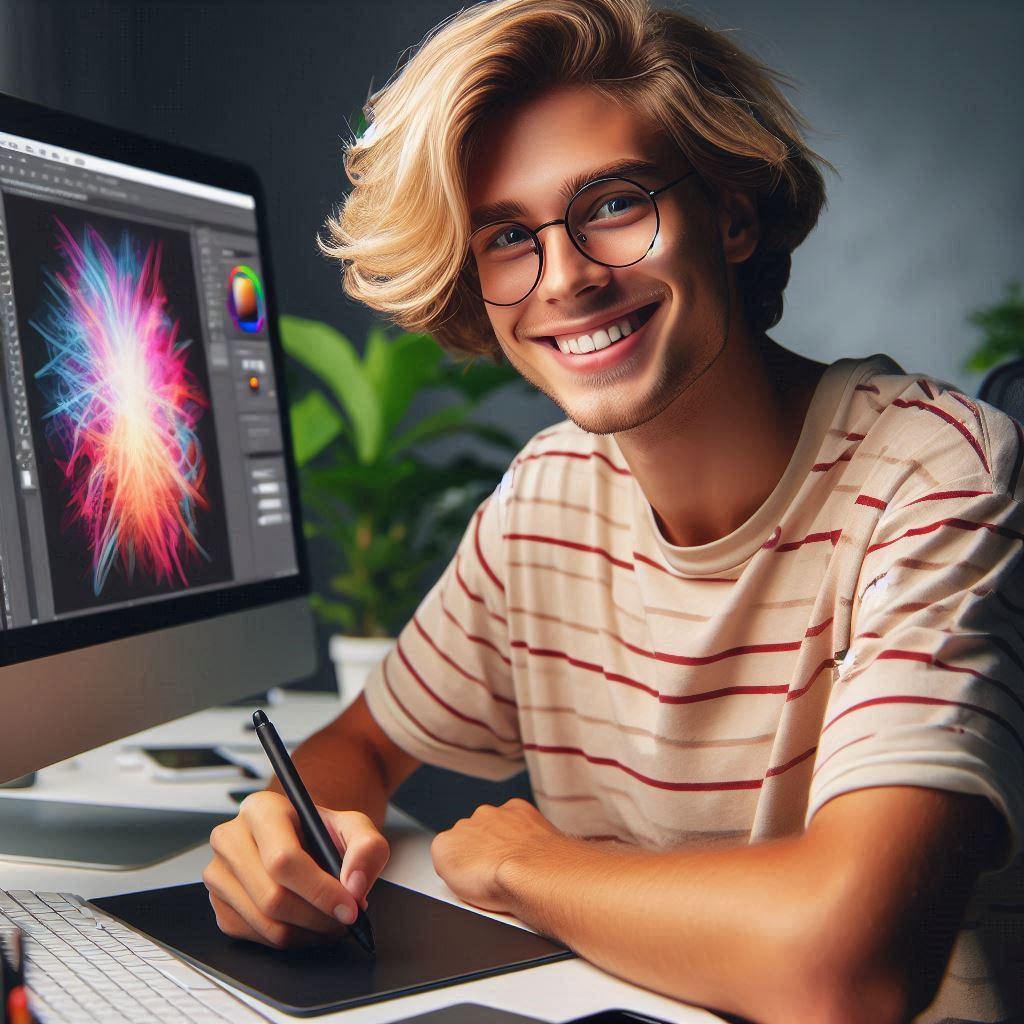Introduction
Overview of Web Design and Graphic Design
Web design focuses on creating websites and web applications.
It involves layout, user interface, and user experience design.
Web designers ensure websites are functional, visually appealing, and user-friendly.
They work with code and design tools to build interactive and responsive sites.
Graphic design, on the other hand, centers on visual communication.
It involves creating visual content for print and digital media.
Graphic designers use typography, imagery, and color to convey messages and ideas.
Their work appears in advertisements, brochures, logos, and branding materials.
Importance of Understanding the Key Differences Between the Two
Understanding the differences between web design and graphic design is crucial.
Each field requires unique skills and knowledge.
Web design demands an understanding of user experience and technical functionality.
Graphic design focuses on static visuals and branding.
Recognizing these differences helps in choosing the right professional for specific projects.
It also clarifies roles in collaborative projects where both disciplines intersect.
Knowing these distinctions ensures effective communication and better project outcomes.
Definition of Web Design
Focus on Creating Websites That Are Functional and User-Friendly
Web design focuses on creating websites that are both functional and user-friendly.
Designers prioritize usability and user experience in their work.
They ensure that websites are easy to navigate and meet user needs.
Functionality includes elements like interactive features, forms, and multimedia.
User-friendliness involves designing intuitive interfaces and clear navigation paths.
The goal is to make websites accessible and engaging for all users.
Designers must consider various devices and screen sizes to ensure a consistent experience.
Effective web design enhances usability and encourages user interaction.
By focusing on these aspects, web designers create websites that serve their intended purpose and satisfy users.
Involves Elements Such as Layout, Navigation, and Typography
Web design involves key elements like layout, navigation, and typography.
The layout determines how content is organized on a webpage.
It affects how users interact with and perceive the website.
Navigation ensures that users can find their way around the site easily.
Clear and logical navigation helps users access information without frustration.
Typography plays a crucial role in readability and aesthetic appeal.
Choosing appropriate fonts and text sizes enhances the overall design.
Designers use these elements to create a visually appealing and functional website.
Effective use of layout, navigation, and typography contributes to a positive user experience.
These elements work together to ensure that the website is both attractive and practical.
Examples of Web Design Tools and Software Used in the Industry
Web designers use a variety of tools and software to create and manage websites.
Adobe XD is popular for designing interactive prototypes and wireframes.
Sketch offers a range of features for UI design and vector graphics.
Figma provides collaborative design capabilities, allowing multiple designers to work together in real-time.
Webflow combines design and development, enabling designers to build responsive websites without extensive coding.
Other tools like InVision and Marvel facilitate design collaboration and feedback.
Designers also use code editors like Sublime Text or Visual Studio Code for writing HTML, CSS, and JavaScript.
Each tool serves specific purposes, helping designers streamline their workflow and produce high-quality websites.
By mastering these tools, designers can efficiently translate their creative ideas into functional web designs.
Definition of Graphic Design
Focus on Creating Visual Content for Print or Digital Media
Graphic design focuses on creating visual content for both print and digital media.
Designers craft elements for brochures, posters, websites, and apps.
They use visual communication to convey messages and evoke emotions.
Graphic design involves producing static imagery for print materials and dynamic content for digital platforms.
The goal is to create designs that are both aesthetically pleasing and functional.
Graphic designers work to ensure that visual elements align with the intended message and audience.
Their work spans various formats, from business cards to social media graphics.
Involves Elements Such as Color Theory, Typography, and Branding
Graphic design heavily relies on elements like color theory, typography, and branding.
Color theory helps designers choose color schemes that create visual harmony and impact.
Typography involves selecting and arranging typefaces to enhance readability and convey tone.
Effective branding uses these elements to build a consistent visual identity for a company or product.
Designers must understand how to apply these principles to different mediums and contexts.
Mastery of color theory ensures that designs evoke the desired emotional response.
Typography affects how easily information is consumed and understood.
Branding ties all visual elements together to form a cohesive identity.
Examples of Graphic Design Software and Tools Used in the Industry
Graphic designers use various software and tools to bring their visions to life.
Adobe Creative Suite is a staple, including Photoshop, Illustrator, and InDesign.
Photoshop is used for image editing and manipulation.
Illustrator is ideal for creating vector graphics and illustrations.
InDesign is employed for layout design, particularly for print media.
Other tools like Sketch and Figma cater to digital design and UI/UX work.
Canva offers a user-friendly option for creating quick designs and social media graphics.
Designers may also use Procreate for digital illustrations on tablets.
Mastery of these tools allows designers to execute their ideas effectively and efficiently.
Read: Breaking Down Iconic Movie Costumes
Key Differences in Purpose
Web Design Focuses on Creating a Seamless User Experience on a Website
Web design primarily aims to create a seamless user experience on a website.
It involves designing layouts that are functional, intuitive, and user-friendly.
Web designers focus on usability, ensuring visitors can easily navigate through the site and find information quickly.
They carefully plan the structure and flow of the website to enhance user interactions.
Key aspects include clear navigation menus, accessible content, and interactive elements that engage users.
Responsive design is crucial, as web designers ensure that websites perform well on various devices, including smartphones, tablets, and desktops.
They also prioritize loading times and performance, optimizing images and code to prevent slowdowns.
Accessibility is another important consideration, making sure the site is usable for people with disabilities.
Effective web design integrates visual elements with functionality, providing a cohesive and enjoyable browsing experience.
Designers often conduct user testing and gather feedback to refine and improve the site.
Iterative design processes help address any issues and enhance usability.
In summary, web design is about creating an engaging and effective online presence where every design choice supports a smooth user experience.
Graphic Design Focuses on Visual Communication and Aesthetics in Design
Graphic design centers on visual communication and aesthetics, aiming to convey messages through visual elements.
Designers use typography, color, imagery, and layout to create impactful and appealing designs.
Their goal is to develop visuals that capture attention and effectively communicate a brand‘s message or identity.
Graphic design is frequently applied to print media, including posters, brochures, and magazines, as well as digital formats such as social media graphics and advertisements.
It focuses on artistic aspects, such as balance, contrast, and alignment, to create visually striking designs.
Graphic designers work on various projects, from developing logos and branding materials to designing packaging and promotional materials.
The emphasis is on creating a strong visual impact that aligns with the intended message and audience.
Designers often employ principles of visual hierarchy and composition to guide viewers‘ attention and convey information clearly.
While functionality is a consideration, the primary focus in graphic design is on aesthetics and visual effectiveness.
The aim is to evoke specific emotions, responses, and brand recognition through compelling visual presentations.
In essence, graphic design is about using design elements to communicate messages powerfully and visually.
Read: Freelance vs. In-House Costume Design Jobs
Key Differences in Skills Required
Web Designers Need to Have Knowledge of Coding Languages Such as HTML, CSS, and JavaScript
Web designers must possess a thorough understanding of coding languages like HTML, CSS, and JavaScript to excel in their field.
HTML, or HyperText Markup Language, structures the content of a webpage, defining elements like headings, paragraphs, and links.
CSS, or Cascading Style Sheets, controls the visual presentation, including layout, colors, and fonts, ensuring the design is aesthetically pleasing.
JavaScript adds interactivity to the website, enabling features such as forms, animations, and dynamic content updates.
Proficiency in these coding languages allows web designers to bring their creative visions to life on the web.
With HTML, they can build the foundational structure of a site.
CSS enables them to style and format this content, creating a visually appealing user experience.
JavaScript enhances user interaction, making websites more engaging and functional.
Knowing how to code is crucial for web designers because it enables them to implement their designs effectively.
It also allows them to troubleshoot issues that may arise during the development process.
For instance, if a layout looks perfect in a design mockup but doesn’t align correctly on the live site, knowledge of HTML and CSS helps web designers identify and fix the problem.
Web designers often collaborate with developers to ensure their designs are technically feasible and functional.
Understanding coding principles enables designers to communicate effectively with developers, bridging the gap between design and technical implementation.
This skill set differentiates web designers from graphic designers, who focus primarily on visual elements rather than web-specific technical requirements.
Graphic Designers Need to Have a Strong Understanding of Design Principles and Composition
Graphic designers need a deep understanding of design principles and composition to create effective and visually appealing designs.
Design principles such as balance, contrast, alignment, and proximity are fundamental to crafting cohesive and impactful visuals.
Balance ensures that visual elements are evenly distributed, creating a sense of harmony.
Contrast helps to highlight important information and create visual interest.
Alignment organizes elements neatly, while proximity groups related items together for better readability.
Also, Graphic designers work with static visuals, such as logos, brochures, posters, and advertisements.
Their focus is on creating designs that communicate messages clearly and attractively.
A strong grasp of color theory is essential for choosing appropriate color schemes that evoke the desired emotional response.
Typography knowledge is crucial for selecting fonts that enhance readability and align with the design’s tone.
Understanding composition helps graphic designers arrange visual elements effectively, guiding the viewer‘s eye and creating a pleasing layout.
This includes the use of grids, white space, and focal points to structure the design.
Unlike web designers, graphic designers do not need to code but must excel in visual design and composition to create compelling and functional graphics.
Read: Networking Events for Costume Designers

Key Differences in Tools and Software
Web Designers Use Tools Like Adobe Dreamweaver, Sketch, and Figma
Web designers utilize a variety of specialized tools to create functional and engaging websites.
Adobe Dreamweaver is a cornerstone in web design, offering a blend of visual and code-based design capabilities.
It allows designers to switch between design and code views, providing a versatile environment for developing complex web pages.
Dreamweaver supports multiple coding languages, making it suitable for various web development tasks.
Sketch is another essential tool for web designers, especially known for its vector-based approach.
It is particularly effective for designing user interfaces and creating responsive layouts.
Sketch‘s symbols and reusable components streamline the design process, enabling efficient creation of consistent designs across multiple screens and devices.
Its user-friendly interface and powerful features make it a popular choice for prototyping and wireframing.
Figma has emerged as a game-changer in the web design space due to its real-time collaboration features.
This cloud-based tool allows multiple designers to work on a project simultaneously, enhancing teamwork and streamlining the feedback process.
Figma‘s component system facilitates design consistency and efficiency, making it easier to manage complex design projects.
Its cloud integration ensures that all team members have access to the latest design updates and assets.
Together, these tools help web designers tackle the challenges of creating responsive, interactive websites.
They enable designers to produce designs that are not only visually appealing but also functional and user-friendly, ensuring a seamless experience across different devices and browsers.
Graphic Designers Use Tools Like Adobe Photoshop, Illustrator, and InDesign
Graphic designers, in contrast, use a different set of tools tailored to their specific needs for creating compelling visual content.
Adobe Photoshop is a fundamental tool for graphic designers, renowned for its photo editing capabilities and raster-based design functions.
It allows designers to manipulate images, create detailed graphics, and apply intricate effects.
Photoshop is indispensable for tasks such as image retouching, digital painting, and creating visually striking graphics.
Adobe Illustrator is another crucial tool in the graphic designer‘s toolkit, specializing in vector-based graphics.
Unlike raster images, vector graphics are scalable without losing quality, making Illustrator ideal for designing logos, icons, and illustrations.
Its precision and flexibility enable graphic designers to create clean, scalable designs suitable for various applications, from print to digital media.
Adobe InDesign is widely used for layout design and is essential for creating multi-page documents such as brochures, magazines, and books.
It provides advanced typography options and layout controls, allowing designers to produce professional-quality print and digital publications.
InDesign‘s robust features support complex layouts and detailed designs, making it the preferred choice for comprehensive print projects.
These tools collectively support graphic designers in producing high-quality visual content across different mediums.
Whether working on print materials or digital graphics, Adobe Photoshop, Illustrator, and InDesign equip designers with the capabilities needed to create polished and impactful designs.
Read: Building a Portfolio for Costume Design
Gain More Insights: Set Designer Salary: How Much Can You Expect to Earn?
Collaboration between Web Designers and Graphic Designers
Web Designers and Graphic Designers Often Work Together on Projects
Note, Web designers and graphic designers frequently collaborate on projects to create cohesive and effective designs.
Web designers focus on creating functional, interactive elements for websites, ensuring a seamless user experience.
They handle layout, navigation, and usability aspects, ensuring the site is user-friendly and responsive.
Graphic designers, on the other hand, concentrate on visual elements like logos, icons, and overall aesthetics.
Their work involves crafting appealing graphics that align with the brand’s identity and message.
When these two roles come together, they combine their expertise to produce a polished final product.
Web designers and graphic designers must align their visions and understand each other‘s contributions.
Web designers rely on graphic designers to provide visual assets that enhance the site‘s appeal.
Graphic designers need web designers to implement these assets effectively into functional web interfaces.
This collaboration ensures that both the visual and functional aspects of a project are addressed.
Successful projects often hinge on effective communication and cooperation between web designers and graphic designers.
Regular meetings and feedback sessions help both parties stay aligned with project goals.
Understanding each other‘s workflows and constraints fosters a smoother collaboration.
By recognizing how each role contributes to the project, both designers can work towards a common objective.
This synergy often results in a more cohesive and engaging end product.
Transform Your Career Today
Unlock a personalized career strategy that drives real results. Get tailored advice and a roadmap designed just for you.
Start NowUnderstanding Each Other‘s Roles and Strengths Can Lead to a Successful Collaboration
Understanding each other’s roles and strengths is crucial for a successful collaboration between web designers and graphic designers.
Web designers specialize in user interface and user experience design, focusing on how a site functions and how users interact with it.
Their strength lies in creating responsive and intuitive designs that enhance usability.
Graphic designers, conversely, excel in creating visually compelling elements that capture attention and convey messages effectively.
They bring expertise in color theory, typography, and visual storytelling.
By acknowledging these differences, both designers can leverage each other‘s strengths.
Web designers can guide graphic designers on how their visual elements will function within the web environment.
In turn, graphic designers can provide insights on how their visuals can enhance the overall user experience.
This mutual understanding helps in creating designs that are both visually appealing and highly functional.
Effective collaboration requires open communication and a willingness to compromise.
Both designers must be receptive to feedback and willing to adapt their work to fit the project’s needs.
Sharing progress updates and discussing potential challenges ensures that both sides are on the same page.
When web designers and graphic designers understand and appreciate each other‘s roles, they can produce a final product that harmoniously blends functionality with aesthetics.
This approach not only improves the quality of the project but also strengthens the working relationship between the two design disciplines.
Delve into the Subject: Salary Expectations for Lighting Designers
Career Opportunities in Web Design and Graphic Design
Web Designers: Working Environments
Web designers often work in various environments, including web development agencies, tech companies, or as freelancers.
In web development agencies, they collaborate with developers to create and implement website designs.
These agencies focus on both the aesthetics and functionality of web solutions.
Tech companies hire web designers to enhance their online presence and user experience.
Working in-house, they align design with the company’s technical and branding goals.
Freelance web designers have the flexibility to work independently with diverse clients, handling all aspects of web design from concept to launch.
Each setting presents unique challenges and opportunities, influencing how web designers approach their work.
Graphic Designers: Working Environments
Graphic designers usually find employment in advertising agencies, marketing firms, or design studios.
At advertising agencies, they craft visuals for campaigns, from print ads to digital content.
These agencies emphasize creative design that captures audience attention and drives engagement.
Marketing firms employ graphic designers to create branding materials, promotional items, and visual content that support marketing strategies.
In design studios, graphic designers work on a range of projects, including logos, packaging, and editorial layouts.
Each environment demands specific skills and creativity, shaping how graphic designers approach design challenges and deliver solutions.
Their roles often involve collaboration with clients and other creative professionals.
Comparing Work Settings
While both web designers and graphic designers create visually appealing content, their work environments differ significantly.
Web designers typically focus on online interfaces and user experiences, often collaborating with tech teams or clients directly.
Their work requires an understanding of web technologies and design principles tailored for digital platforms.
In contrast, graphic designers generally work on static visuals for print and digital media.
They focus on branding, marketing materials, and visual communication strategies.
Their work often involves adapting designs for various media and ensuring consistency across different formats.
Understanding these differences can help clarify the distinct skills and expertise each role brings to the table.
See Related Content: Navigating Career Growth in Product Design
Conclusion
Web design and graphic design, though closely related, serve distinct purposes and require different skills.
Web design focuses on creating user-friendly, interactive websites.
It involves designing layouts, navigation, and ensuring responsiveness across devices.
Web designers must understand HTML, CSS, and JavaScript to implement their designs effectively.
Graphic design, on the other hand, centers on creating visual content for print and digital media.
It includes designing logos, brochures, and advertisements.
Graphic designers concentrate on aesthetics, typography, and visual storytelling.
They use tools like Adobe Illustrator and Photoshop to craft visually compelling materials.
Understanding these key differences is crucial for a successful design career.
Web design requires a grasp of user experience (UX) and user interface (UI) principles.
It also demands knowledge of coding and technical constraints.
Graphic design, however, emphasizes visual composition, branding, and print specifications.
Familiarity with both disciplines can greatly benefit your career.
Combining skills from both areas enables you to create cohesive designs that work across various platforms.
This versatility enhances your employability and opens up a wider range of opportunities.
[E-Books for Sale]
The Big Book of 500 High-Paying Jobs in America: Unlock Your Earning Potential
$19.99 • 500 High-Paying Jobs • 330 pages
Explore 500 high-paying jobs in America and learn how to boost your career, earn more, and achieve success!
See All 500 High-Paying Jobs of this E-Book
1001 Professions Without a Degree: High-Paying American Jobs You Can Start Now
$19.99 • 1001 Professions Without a Degree • 174 pages
Discover 1001 high-paying jobs without a degree! Unlock career tips, skills, and success strategies for just $19.99!




